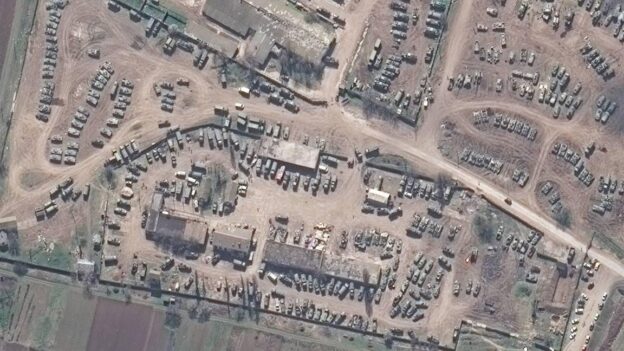Russian vehicles in Dzhankoy in the spring of 2022.
Maxar imagery
Dzhankoy, a rail and road hub in northern Crimea, 50 miles south of the Ukrainian mainland, was a critical node in Russia’s supply network before September, when Ukrainian forces launched a counteroffensive that ultimately liberated much of Russian-occupied southern Ukraine.
Now, as Russian field armies reposition on the left bank of the Dnipro River, just south of the newly-liberated port city of Kherson, Dzhankoy is even more important to the Russian war effort. The Kremlin is reorganizing its supply network for the southern front. Dzhankoy is at the center of the new network.
Ukrainian planners know this. So it should come as no surprise that Dzhankoy now is a top target of Ukraine’s long counterlogistics campaign.
With a prewar population of just 39,000, Dzhankoy isn’t a big town. But it lies astride the main rail line running from southern Russia, across the bridge over the Kerch Strait and into northern Crimea and southern Kherson Oblast on the Dnipro’s left bank. The Esrc05 and E97 roads also intersect in Dzhankoy.
The canal carrying fresh water from the Dnipro into Crimea runs through the town. There also is an airfield in Dzhankoy.
Dzhankoy was an obvious base of operations for the scores of Russian battalions that assembled in Crimea for the wider attack on southern Ukraine that kicked off in late February. The Russians quickly captured much of southern Ukraine, putting Dzhankoy beyond range of most of Ukraine’s weaponry.
Dzhankoy.
Google Maps
That began to change in May, as Ukrainian forces rearmed with U.S.-made High-Mobility Artillery Rocket Systems and the latest European howitzers—and began bombarding Russian supply lines. The counterlogistics campaign peaked on Oct. 8, when Ukrainian saboteurs triggered a truck bomb that badly damaged the Kerch Bridge.
Where before the bridge had two high-capacity rail lines, it now has just one line—and its capacity probably is lower. Repairs won’t wrap up until well into 2023. To compensate, the Russians have been hauling more supplies to Crimea and southern Ukraine by ship.
Once in Crimea, those supplies still travel by rail and road—and pass through Dzhankoy. As Ukraine’s counterlogistics campaign escalated in August, Ukrainian forces—possibly HIMARS operating at the edges of its striking range—struck the airfield in Dzhankoy, triggering explosions that wrecked ammunition dumps and scattered munitions along nearby roads. The Ukrainians hit Dzhankoy again on Nov. src6.
The strikes didn’t alter the Kremlin’s heavy reliance on Dzhankoy. Indeed, as Russian forces retreated from southern Ukraine north of the Dnipro starting in September, more and more critical support functions relocated to the northern Crimean town. The Ukrainian general staff on Saturday even noted a new live-fire range in Dzhankoy where Russian battalions can give their draftees a bit of training before shoving them toward the front.
The Ukrainian strikes on Dzhankoy are a prerequisite for a possible future Ukrainian counteroffensive aimed at finally liberating Crimea from its nearly decade-long occupation. Anticipating this attack, the Russians this month began fortifying the area around Dzhankoy, according to Andrii Chernyak, a spokesperson for Ukraine’s Main Intelligence Directorate.
But the Ukrainians wouldn’t launch a ground attack on Crimea unless and until they’d eroded the Russians’ logistics on the peninsula—in large part by bombarding Dzhankoy and rendering it unsafe for Russian trains, trucks and aircraft. By the time Ukrainian brigades are running into defensive earthworks around Dzhankoy, Dzhankoy itself probably already is in ruins.
Follow me on Twitter. Check out my website or some of my other work here. Send me a secure tip.

Comments are closed